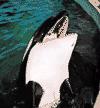- killer whale
-
any of several predatory dolphins, esp. the black-and-white Orcinus orca, found in all seas.[1880-85]
* * *
or orcaLargest of the dolphins, the male may be 30 ft (9 m) long and weigh over 10,000 lbs (4,500 kg). The killer whale is black, with white on the underparts, above each eye, and on each flank. The snout is blunt, and the strong jaws have 40–50 large, sharp, conical teeth. Killer whales live in groups of a few to about 50 individuals. They feed on fishes, cephalopods, penguins, and marine mammals; though they are fierce predators of seals and even other whales, there is no recorded instance of a killer whale attacking a human. They are often kept in captivity and trained as performers in marine shows. Killer whale (Orcinus orca).Miami Seaquarium
Killer whale (Orcinus orca).Miami Seaquarium* * *
▪ whalelargest member of the dolphin family (Delphinidae). The killer whale is easy to identify by its size and striking coloration: jet-black on top and pure white below with a white patch behind each eye, another extending up each flank, and a variable “saddle patch” just behind the dorsal fin. Despite the fact that this cetacean is a powerful carnivore, there is no record of its killing humans in the wild. Dozens of killer whales have been kept in captivity and trained as performers.Males regularly attain a length of more than 8 metres (26 feet) and a weight of about 4.5 metric tons (5 short [U.S.] tons), whereas females reach about 7 metres and weigh significantly less. Anecdotal reports, however, suggest maximum lengths of 9.8 metres for males and 8.5 metres for females; a weight surpassing 7 metric tons was recorded for one large male. Males also have proportionally larger appendages, with flippers up to 2 metres long—approximately 20 percent of the body length—and almost 1 metre wide. Flipper length among females is 11–13 percent of body length. The dorsal fin of older males is very tall (up to 1.8 metres) and straight; females and young males have a dorsal fin that is about half that size and distinctly sickle-shaped (falcate). The skull is a metre or more in length and holds the largest brain of all the dolphins, averaging 5.6 kg (12.3 pounds). The muscles that close the mouth are enormous, and within the jaws is a set of more than 40 interlocking, curved teeth. Most of the teeth are large, measuring about 10 cm (4 inches) long and 4 cm wide.The killer whale has a patchy distribution in all oceans, from the polar ice caps to the Equator, where large prey such as tuna, salmon, and seals are abundant. Other food sources are squid, sea lions, porpoises, dolphins, and other whales. In the North Pacific local resident populations live along the Alaskan coast, in the intracoastal waterways of British Columbia and Washington, and off the coast of Baja California. In the North Atlantic they can be found from the waters off Newfoundland and Labrador to Iceland, Norway, and the British Isles. In the Southern Hemisphere killer whales can be seen off the coasts of Argentina, South Africa, New Zealand, and the Galapagos Islands.Killer whales live in small groups, usually called pods, that number fewer than 40 individuals each. Resident and transient pods have been differentiated within the populations of British Columbia and Washington. Sound production and diet differ between them, with resident pods eating fish (primarily salmon) and transients eating other cetaceans, seabirds, and seals. echolocation is used by killer whales in feeding and communication.The evolutionary record of the genus Orca is scanty. The earliest fossil identified as a killer whale is Orcinus citonensis from the Pliocene Epoch (5.3 million to 1.8 million years ago) in Italy. This small mammal was about 4 metres long and had 14 teeth—more like a typical dolphin. This implies that the ancestors of the present-day killer whale diverged from other cetaceans during the Miocene Epoch (23.8 million to 5.3 million years ago); most dolphin evolution took place near the beginning of this epoch.Although the taxonomy of the killer whale is clear at the genus level (Orca) and family level (Delphinidae), relationships between killer whales and other toothed whales (toothed whale) (suborder Odontoceti) are ambiguous. The false killer whale (Pseudorca crassidens), pygmy killer whale (Feresa attenuata), Risso's dolphin (Grampus griseus), and pilot whales (pilot whale) (Globicephala species) have been thought to be relatives of the killer whale. Killer whales are sometimes assigned to one or another subfamily of the Delphinidae: Orcininae (killer whales and kin) or Globicephalinae (pilot whales and kin). More than 20 species names have been applied to the killer whale, but a consensus now recognizes only Orcinus orca. Killer whales were formerly referred to as grampuses (grampus), but this term is now a synonym for Risso's dolphin (grampus).Additional ReadingComprehensive and readily available works include Peter Knudtson, Orca: Visions of the Killer Whale (1996); and Erich Hoyt, The Whale Called Killer (1981). A video documentary, Nicolas Noxon and Aram Boyajian, Wolves of the Sea (1993), was produced by the National Geographic Society.For scientific information, consult S.H. Ridgway and R. Harrison (eds.), The Second Book of Dolphins and Porpoises (1999), vol. 6 of Handbook of Marine Mammals; and Barbara C. Kirkevold and Joan S. Lockard (eds.), Behavioral Biology of Killer Whales (1986).* * *
Universalium. 2010.
